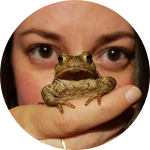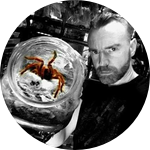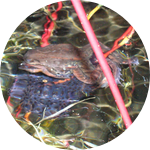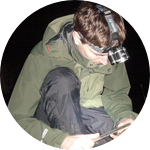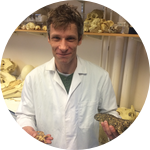About This Project
The midwife toad (Alytes obstetricans) is an alien species, first introduced to the UK over 100 years ago. It has long been assumed that all of the known populations have a French origin, being sourced from the original founding population in Bedford. Whilst carrying out studies on the Cambridge population, it was determined that the toads there originated from Spain. Now we aim to sequence DNA from up to 100 toads, ≥5 toads from 20 known populations to build a haplotype map
Ask the Scientists
Join The DiscussionWhat is the context of this research?
Midwife toads are a non-native species in the UK. We don't know how many colonies exist. The assumption today is that the first established population, the Bedford population, acted as a source population for other colonies. A recent discovery shows that the Cambridge population is of Spanish origin (with the Bedford toads being of French origin). We hypothesise that other populations have different introduction pathways. For a century, the literature stated the Bedford midwife toads are of French origin, yet this has not been verified this with genetics. We will extract and sequence DNA from the Bedford population and others to check if these toads are of French origin. Though, the results may show results that could over turn a century of scientific assumption.
What is the significance of this project?
We intend to produce a partial, if not complete, haplotype map of the UK's midwife toad populations. These data will allow us to identify populations where midwife toads have been used to found new populations, such as the Bedford population. Our expectation is not all of the introductions will be independent of one another. We expect some populations to be scarcely documented with their origins completely unknown. We will publish the data we produce in an open access journal and all DNA sequences will be uploaded to GenBank and made freely available to anyone to use for future analysis.
What are the goals of the project?
The project aims to collect mitochondrial DNA using non-invasive techniques from populations of the introduced midwife toad (A. obstetricans) throughout the UK. These samples will then be sent to a colleague’s lab (Rob Gandola, University College Dublin) where the DNA will be extracted before being sent off to be sequenced. Due to the likelihood of a small number of founding individuals and the cryptic nature of the toads, between 5 and 10 individuals will be sampled per population. We aim to validate whether or not the Bedford population originated from France as well as identifying the introduction pathway of the midwife toad populations we are able to take samples from.
Budget
To date we have only managed to raise £300 towards to the project which has facilitated the purchase of some of the required lab reagents/consumables. No extractions have yet been completed as we haven't been able to secure the funds for the subsequent sequencing.
With the $1000 we hope to raise through this crowdfunder, we will be able to extract and sequence approximately 100 samples (equal to a maximum of 20 populations). The money will assist us in aiding to sequence the samples we already have as well as those that we plan to collect in the future. This is significant as it this will give us everything we need to analyse samples from the majority of the known midwife toad populations in the UK.
All of the money raised as part of this crowdfunding campaign will be used directly to fund the necessary lab work.
Endorsed by
 Project Timeline
Project Timeline
We expect that the project will last between 12-18 months in order to allow for the collection of samples and the time needed to complete the extraction/sequencing.
We also need to identify other populations that can be visited to collect samples from. Not every population will require us to visit as there is a network of national herpetologist citizen scientists who may be able to help. However we are fully prepared to do so if this is required.
Aug 08, 2019
Project Launched
Sep 30, 2019
Extract and sequence the 60 samples already gathered
Nov 30, 2019
Identify potential populations to survey in 2020
Aug 31, 2020
Survey and collect buccal swabs from the newly identified populations (ideally 5 or more populations)
Oct 31, 2020
Extract and sequence the samples collected in 2020
Meet the Team
Affiliates
Affiliates
Affiliates
Steven J R Allain
I'm a currently a PhD candidate at the University of Kent where my research focuses on the population dynamics of the barred grass snake (Natrix helvetica). I hold a BSc in Zoology from Anglia Ruskin University and an MRes in Ecology, Evolution and Conservation from Imperial College London. My main academic interests have been amphibian population monitoring and the influence of disease, which I have been studying since 2013. From 2018 I have been on the council of the British Herpetological Society and through my research, I'm intrinsically linked to amphibian and reptile conservation in the UK.
John W. Wilkinson
I'm Regional, Training and Science Programmes manager for the Amphibian & Reptile Conservation Trust. I've a particular interest in conservation of amphibians, especially toads (Bufo, Bufotes, Epidalea) and in the effects of non-native species.
Mark James Goodman
Graduated in Zoology in 2015 alongside my colleague Steven. I have been interested in amphibians and reptiles from childhood. I decided to leave my position of nearly 14 years at BT in 2011 to study Zoology. I am the current Toads on Roads officer for (CPARG) Cambridge and Peterborough Amphibian & Reptile Group and survey multiple populations across Cambridgeshire. We attend many events throughout the year in an effort to teach and inspire the general public and most importantly show these beautiful animals for what they are.
I am co-author with Steven for several articles regarding (GCN's) Great Crested Newts and various other species in and around Cambridge.
Rob Gandola
I co-ordinate the science agenda for the Herpetological Society of Ireland where I lead and supervise research on the ecology and conservation of reptiles and amphibians in Ireland and further afield. I am a Ph.D student at University College Dublin where my research primarily focuses on the conservation and ecology of Nile crocodiles in Madagascar.
Additional Information
So far we've managed to collect samples from a small number of populations using minimally invasive buccal swabbing. These have been collected by ourselves or citizen scientists. Once we’ve received the sequences, these will be analysed using a comprehensive reference database to identify where the toads originated (GenBank). As already stated, we aim to collect between 5 and 10 samples per population to try to give a clear picture of the haplotype diversity within each population; however this depends on access and the size of those populations
Unfortunately on continental Europe where the midwife toad is native, habitat loss and disease is having a dramatic effect on populations. Once a population within the UK has a known source, there is the possibility that individuals may be used in the future for captive breeding efforts for reintroduction to the wild back in their native country. The reason being is that the midwife toad populations here in the UK seem to relatively stable at present.
Midwife toads are also highly susceptible to the amphibian chytrid fungus (Batrachochytrium dendrobatidis) and so could be used as an indicator that local amphibian species are infected. So far, the limited screening that has been completed in the UK for introduced midwife toads suggests they are negative for chytrid in the population tested.
Project Backers
- 45Backers
- 124%Funded
- $1,242Total Donations
- $27.60Average Donation
